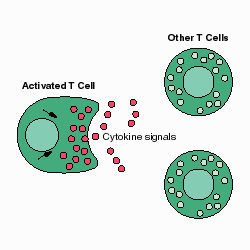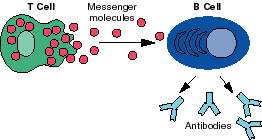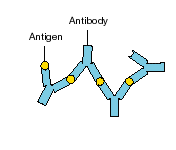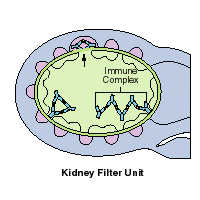Antibodies & Disease
Sat, 31 May 2008 17:55:07
By Imran Khan, MBBS.,
AntiBody and disease
 Return
to first page of autoimmune disease
Return
to first page of autoimmune disease
After the antigen-presenting cell and T cell interact through the MHC, T-cell receptor and co-stimumlatory and molecules, the T cell becomes activated, sending cytokine signals to other cells.
Chemokines are small cytokine molecules that attract cells of the immune system. Overproduction of chemokines contributes to the invasion and inflammation of the target organ, which occurs in autoimmune diseases. For example, overproduction of chemokines in the joints of people with rheumatoid arthritis may result in invasion of the joint space by destructive immune system cells such as macrophages, neutrophils, and T cells.
For prevention and alternative treatments of all diseases, "Flame within contents".B cells are another critical type of immune system cell. They participate in the removal of foreign antigens from the body by using a surface molecule to bind the antigen or by making specific antibodies that can search out and destroy specific foreign antigens. However, the B cell can only make antibodies when it receives the appropriate command signal from a T cell. Once the T cell signals the B cell with a type of cytokine that acts as a messenger molecule, the B cell is able to produce a unique antibody that targets a particular antigen.
 .
.
A T cell sends messenger molecules, e.g. cytokines, to the B cell, which allows the B cell to start making antibodies.
AutoantibodiesIn some autoimmune diseases, B cells mistakenly make antibodies against tissues of the body (self antigens) instead of foreign antigens. Occasionally, these autoantibodies either interfere with the normal function of the tissues or initiate destruction of the tissues. People with myasthenia gravis experience muscle weakness because autoantibodies attack a part of the nerve that stimulates muscle movement. In the skin disease pemphigus vulgaris, autoantibodies are misdirected against cells in the skin. The accumulation of antibodies in the skin activates other molecules and cells to break down, resulting in skin blisters.
Immune Complexes and the Complement System
When many antibodies are bound to antigens in the bloodstream, they form a large lattice network called an immune complex. Immune complexes are harmful when they accumulate and initiate inflammation
 within
small blood vessels that nourish tissues. Immune complexes,
immune cells, and inflammatory molecules can block blood
flow and ultimately destroy organs such as the kidney. This
can occur in people with systemic lupus erythematosus.
within
small blood vessels that nourish tissues. Immune complexes,
immune cells, and inflammatory molecules can block blood
flow and ultimately destroy organs such as the kidney. This
can occur in people with systemic lupus erythematosus. A
group of specialized molecules that form the complement
system helps to remove immune complexes. The different
types of molecules of the complement system, which are found
in the bloodstream and on the surfaces of cells, make immune
complexes more soluble. Complement molecules prevent
formation and reduce the size of immune complexes so they do
not accumulate in the wrong places (organs and tissues of
the body). Rarely, some people inherit defective genes for a
complement molecule from their parents. Because these
individuals cannot make a normal amount or type of
complement molecule, their immune systems are unable to
prevent immune complexes from being deposited in different
tissues and organs. These people develop a disease that is
not autoimmune but resembles lupus erythematosus.
A
group of specialized molecules that form the complement
system helps to remove immune complexes. The different
types of molecules of the complement system, which are found
in the bloodstream and on the surfaces of cells, make immune
complexes more soluble. Complement molecules prevent
formation and reduce the size of immune complexes so they do
not accumulate in the wrong places (organs and tissues of
the body). Rarely, some people inherit defective genes for a
complement molecule from their parents. Because these
individuals cannot make a normal amount or type of
complement molecule, their immune systems are unable to
prevent immune complexes from being deposited in different
tissues and organs. These people develop a disease that is
not autoimmune but resembles lupus erythematosus.
Nerves Click to view different size nerve fibers.
Pathalogy in CIDP and autoimmune diseases GlomerulonephritisAutoimmune Diseases Treatment
Electrical Stimulation Therapy
magnets and ageing
Sand Bath
Glutathione supplement
Sulphur Bath
Massage Cancer Cure
Water chestnut nutrition
Infants women omega-3
Selenium the specialfood
Capsaicin
North American Herbs
Small fiber neuropathy
Gout Garlic
Magnetic deficiency
Pathology
Variants
CIDP
info
Fibromyalgia
IVIG
Diet
Burning Feet Home
Services Page
Chronic Fatigue
Autoimmune diseases
Prognosis
Bible healing
Celiac disease